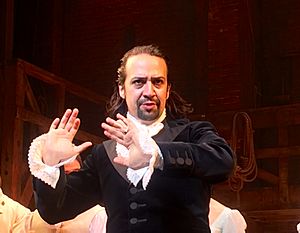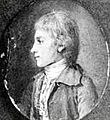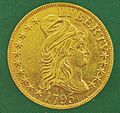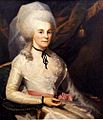Alexander Hamilton facts for kids
Quick facts for kids
Alexander Hamilton
|
|
|---|---|
 |
|
| 1st Secretary of the Treasury | |
| In office September 11, 1789 – January 31, 1795 |
|
| President | George Washington |
| Preceded by | Position established |
| Succeeded by | Oliver Wolcott Jr. |
| Senior Officer of the United States Army | |
| In office December 14, 1799 – June 15, 1800 |
|
| President | John Adams |
| Preceded by | George Washington |
| Succeeded by | James Wilkinson |
| Delegate to the Congress of the Confederation from New York |
|
| In office November 3, 1788 – March 2, 1789 |
|
| Preceded by | Egbert Benson |
| Succeeded by | Seat abolished |
| In office November 4, 1782 – June 21, 1783 |
|
| Preceded by | Seat established |
| Succeeded by | Seat abolished |
| Personal details | |
| Born | January 11, 1755 or 1757 Charlestown, Nevis, British Leeward Islands |
| Died | July 12, 1804 (aged 47 or 49) New York City, New York |
| Resting place | Trinity Church Cemetery |
| Political party | Federalist |
| Spouse |
Elizabeth Schuyler
(m. 1780) |
| Children | Philip Hamilton Angelica Hamilton Alexander Hamilton Jr. James Alexander Hamilton John Church Hamilton William S. Hamilton Eliza Hamilton Holly Philip Hamilton (the second) |
| Parents | James A. Hamilton Rachel Faucette |
| Education | King's College (renamed Columbia) |
| Signature | |
| Military service | |
| Allegiance | |
| Branch/service | |
| Years of service | 1775–1776 (Militia) 1776–1781 1798–1800 |
| Rank | |
| Commands | U.S. Army Senior Officer |
| Battles/wars | American Revolutionary War • Battle of Harlem Heights • Battle of White Plains • Battle of Trenton • Battle of Princeton • Battle of Brandywine • Battle of Germantown • Battle of Monmouth • Siege of Yorktown Quasi-War |
Alexander Hamilton (born January 11, 1755 or 1757 – died July 12, 1804) was an important leader in early American history. He was a statesman (a skilled government leader), a political thinker, and an economist (someone who studies money and resources). Hamilton was one of the Founding Fathers of the United States, who helped create the country.
He became the first Secretary of the Treasury for the United States. He is well-known for helping to create a national bank for the country. Hamilton was born on the island of Nevis in the Caribbean. He later moved to New York City.
When the American Revolutionary War began, Hamilton joined the Continental Army. He was a close assistant to General George Washington. After the war, he became a lawyer. He also helped write the United States Constitution. With James Madison and John Jay, he wrote the Federalist Papers. These essays helped convince people to support the new Constitution.
As Secretary of the Treasury under President George Washington, Hamilton helped set up the United States' money system. He strongly supported having a national bank. Hamilton was a leader of the Federalist Party. He was a long-time rival (competitor) of Thomas Jefferson. Sadly, Hamilton died in a duel with his political rival Aaron Burr in 1804.
Today, many people see Hamilton as one of the most important early American leaders. His portrait is on the United States ten-dollar bill.
Contents
Hamilton's Early Life
Alexander Hamilton was not born in the United States. He was from the Caribbean island of Nevis. His father was James Hamilton, and his mother was Rachel Fawcett Lavien. His father left the family when Alexander was young. A few years later, both Hamilton and his mother became very sick. Hamilton got better, but his mother passed away.
In 1772, Hamilton traveled to New York to continue his education. He went to Kings College (now called Columbia College, part of Columbia University) until 1776.
Hamilton's Career in Government
Joining the American Revolution
When the American Revolution began, Hamilton first served as an artillery officer. Later, he became a trusted assistant on George Washington's staff. By the late 1780s, Hamilton believed that the Articles of Confederation made the government too weak. He thought a new document was needed to make the country stronger.
Writing the Constitution
Hamilton was chosen as a delegate (representative) to the Constitutional Convention. He was one of the people who signed the new Constitution.
In 1789, he helped write the Federalist Papers. This was a series of essays written by Hamilton, John Jay, and James Madison. They used the pen name "Publius." Hamilton wrote about two-thirds of these essays. They were printed in newspapers in New York and explained why the new Constitution was a good idea. These writings are still considered very important American works on politics and government today.
First Secretary of the Treasury
George Washington became President in 1789. He chose Hamilton to be the first United States Secretary of the Treasury. As Secretary of the Treasury, Hamilton supported creating a national bank. He also came up with a plan to pay off the debt the country owed from the Revolutionary War. These actions helped to build a strong financial system for the new nation.
Hamilton also helped start the Federalist Party. John Adams was a member of this party, and Washington supported its ideas, even though he wasn't officially a member. After serving as Secretary of the Treasury, Hamilton worked as a lawyer. He continued to be a leader of the Federalist Party.
Views on Slavery and Religion
Hamilton said he was against slavery. He worked with John Jay as a leader of the New York Manumission Society. This group tried to end slavery in New York by encouraging slave owners to free their slaves. However, it is known that he also bought and sold slaves for himself, his family, and his friends.
Hamilton also respected the small Jewish community in America. He was a strong supporter of religious freedom for everyone.
In 1800, Hamilton's political rival Thomas Jefferson won the presidential election against the Federalist John Adams. Jefferson and Hamilton had very different ideas about how the new country should be run. But both were important Founding Fathers.
The Duel and Hamilton's Death
Hamilton had a long-standing rivalry with Aaron Burr, who was Jefferson's vice president. Hamilton played a role in Burr not being chosen again for Vice President. He also worked to prevent Burr from becoming Governor of New York. Because of this, Burr challenged Hamilton to a duel.
They agreed to meet on July 11, 1804, in Weehawken, New Jersey. Dueling was illegal in New York, which is why they chose Weehawken. This was also the same place where Hamilton's son, Philip Hamilton, had been killed in a duel three years earlier. The night before the duel, Hamilton wrote his will and letters to his friends and his wife.
At dawn the next morning, the two men met. They took their positions without talking. It's not known who fired first, but Burr's bullet hit Hamilton. The bullet went through Hamilton's ribs and hurt his lungs and liver. Hamilton was taken to a friend's house in Manhattan. His wife and children came to be with him. He asked two ministers for Communion but was refused at first. Finally, the Episcopal Bishop Benjamin Moore gave him the sacrament. Hamilton passed away the next morning.
Hamilton's Lasting Impact

- Hamilton is shown on the front of the U.S. 10 dollar bill. He is one of only two non-presidents to be honored on commonly used money.
- Some of Hamilton's famous quotes are still used today, like: "I never expect a perfect work from an imperfect man."
- Hamilton started the United States Revenue Cutter Service. This group later became the United States Coast Guard in 1915. Because of this, he is called the "father of the United States Coast Guard."
- He believed in a strong central government, unlike some other Founding Fathers. During his life, he was involved in almost every major political event from the Revolution to the election of 1800.
- His writings fill 27 large books! Even with all his writings, he is sometimes less understood than other Founding Fathers.
- By the time Hamilton died, the Federalist Party he helped create was becoming less powerful. However, Hamilton and the Federalists had convinced Washington to create a central bank, take on the states' debts, and pass tax laws. These actions greatly helped the new democracy survive.
- In 2015, Alexander Hamilton became very popular in popular culture because of the hit Broadway show Hamilton: An American Musical. It was written by Lin-Manuel Miranda, who also played Alexander Hamilton in the first public performances. The show won many awards, including Drama Desk Awards, the Pulitzer Prize for Drama, and the Best Musical.
Famous Quotes by Alexander Hamilton
- "Those who stand for nothing fall for everything.”
- “The constitution shall never be construed...to prevent the people of the United States who are peaceable citizens from keeping their own arms.”
- “A nation which can prefer disgrace to danger is prepared for a master, and deserves one.”
- “Safety from external danger is the most powerful director of national conduct. Even the ardent love of liberty will, after a time, give way to its dictates. To be more safe, they at length become willing to run the risk of being less free.”
- “If men were angels, no government would be necessary.”
Interesting Facts About Alexander Hamilton
- People in Nevis (where Alexander Hamilton was born) were so impressed with his writing in the local newspaper. They collected enough money to send him to King's College in New York City. This college is now called Columbia College.
- Alexander fought in the Continental Army as a captain. He also served as an aide to George Washington.
- After the war, Hamilton studied for only six months. Then he passed the bar exam to become a lawyer. He defended many British Loyalists (people who stayed loyal to Britain).
- The Federalist Papers that Hamilton helped write were mostly read in New York. They were not as widely read in other parts of the country.
- Hamilton helped create the mint in Philadelphia. A mint is a place that makes a country's money.
- Because Alexander Hamilton loved to write, he started a newspaper. He called it the New York Evening Post. It is now known as the New York Post.
- Hamilton did not like either Thomas Jefferson or Aaron Burr. Both were running in the 1800 presidential election. He chose to help Jefferson get elected over Burr. He saw Jefferson as the "lesser of two evils."
- Alexander Hamilton was involved in 12 attempted duels during his life. The duel with Aaron Burr was his last.
- Dueling was illegal in New York. So, Hamilton and Burr went to New Jersey at dawn on July 11, 1804, to fight their duel.
Images for kids
-
The Hamilton House, Charlestown, Nevis. This building was rebuilt from the ruins of the house where Alexander Hamilton was thought to be born.
-
Kings College around 1756. It was next to the New York Commons, where City Hall Park is today.
-
Aides-de-camp's office inside Washington's Headquarters at Valley Forge. General Washington's staff officers worked here.
-
A close-up from Surrender of Lord Cornwallis by John Trumbull. It shows Colonels Alexander Hamilton, John Laurens, and Walter Stewart.
-
A small portrait of Hamilton, believed to be by Charles Shirreff, around 1790.
-
A painting of a Revenue Marine cutter. This might be the Massachusetts (1791) or its replacement.
-
A statue of Hamilton by Franklin Simmons. It overlooks the Great Falls of the Passaic River in Paterson, New Jersey. Hamilton imagined using the falls to power new factories.
-
The Jay Treaty.
-
Hamilton by John Trumbull, 1792.
-
A statue of Hamilton in the United States Capitol rotunda.
-
A close-up of an 1802 portrait by Ezra Ames. It was painted after the death of Hamilton's oldest son, Philip.
-
Hamilton's tomb in Trinity Church's first burial grounds. It is located at Wall Street and Broadway in Lower Manhattan.
-
A drawing (around 1902) of the Burr–Hamilton duel, from a painting by J. Mund.
-
The seal for the USCGC Hamilton (WMSL 753). The colors on the coat of arms show two parts of Alexander Hamilton's life: military and civilian.
See also
 In Spanish: Alexander Hamilton para niños
In Spanish: Alexander Hamilton para niños






























